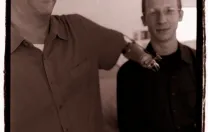Perusing the course catalog for first-year Harvard Medical School (HMS) students, Mark Hanudel felt that “Living with Life-Threatening Illness” was a must for satisfying his first-year elective requirement in social medicine. “We don’t get that much education on how to talk with patients at the end of their lives,” he says. “Interacting with a patient and family this way seemed like an experience I couldn’t pass up.”
For Hanudel and other students in the school’s M.D. program, the course was part of a first-year curriculum that concentrates on how the human body works and how the natural sciences are applied to medicine.
These students generally follow one of two programs, “New Pathway” or Health Sciences and Technology (HST). The former, which draws about 135 medical students a year, emphasizes small-group and case-based learning, complemented by lectures, laboratory work, and conferences. Classes cover such basic topics as genetics, immunology, and pharmacology, as well as biostatistics and the patient-doctor relationship.
The smaller HST program gives students access to courses at Harvard and MIT and takes a more quantitative approach that focuses on molecular biology, biotechnology, physical sciences, and engineering. Classes are held separately from those in the New Pathway program, but they overlap in electives like “Living with Life-Threatening Illness” and in various aspects of student life. Only about 30 students are admitted to this program each year, and many carry out research in labs at MIT, Harvard, and affiliated hospitals as part of their studies.
“Living” isn’t the only exposure to patient-doctor relationships during students’ early years, although it is the only one targeting end-of-life care. For example, the “Patient/Doctor” class required for all students offers instruction in taking medical histories and conducting physical exams. There’s also an elective called “Mentored Casebook” that matches each enrolled student with a patient and his or her physician. The student spends several months observing from both sides of the stethoscope and then produces an extensive chronicle of the experience.
Launched in 1985, the New Pathway curriculum is in the midst of a review examining both the first two (preclinical) years—where most learning happens in the classroom—and the subsequent two patient-centered years. One goal, according to Jane Neill, associate dean for medical education planning and administration, is to better integrate courses and encourage more interaction among faculty and students. The changes, slated to be rolled out in the fall of 2006, also include giving first-years an overview of the medical profession before classes officially start.
Although plans are still being refined, says Neill, “It is certainly possible that more courses like ‘Living with Life-Threatening Illness’ could be incorporated into the curriculum as electives.”





